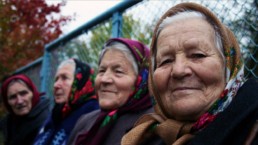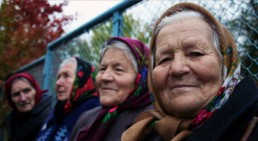Review: ‘The Babushkas of Chernobyl’
Documentaries of this caliber do not come around often, and this fascinating film is worth noting with high esteem.
Premiering at the LA Film Festival, and receiving a jury award for Directing, is the exploratory documentary The Babushkas of Chernobyl, a look at the repercussions of radioactive activity on culture and society.
In 1986, the Chernobyl Power Plant exploded, exposing a radius of 25 kilometers to toxic radiation. Plants, buildings, water, and people were all at risk. The result was a mass forced evacuation, and hundreds of people were unknowingly removed from where they had been living for hundreds of years. Many people’s lives were ruined in the process, never able to return home. For a brave few, there was no choice but to illegally return home despite the potential danger, and that is exactly what they did. This is their story.
Approximately 200 people currently live in the danger zone, and today the level of radiation is just as strong as it was back then. Peculiarly, the majority of these people are women, and all of them are elderly, known as Babushkas which is the Russian and Polish word for grandmother. Despite the potential dangers, their lives continue in quiet isolation within the radiation zone, and it does not stop them from any other activity.
It isn’t an understatement to say that the film is fascinating on all levels.
Because of their ages, the government has allowed them to stay, and they are supported with sparse care. Scientists take samples to see what the radiation looks like in everything they use: food, soil, water, clothing. To them, there is no question that they would prefer to be in their homeland despite the risk. Astonishingly, they live healthy, jovial lives isolated from other worldly dangers. Because of their isolation, they live incredibly close to the land, growing their own food, raising their own meat, brewing their own moonshine, and living with an understanding of the natural world exponentially better than those of us in modern urban environments.
The community is almost entirely female and they band together and accomplish tasks that are impressive for women who are all around the age of 80.
These primary subjects are fascinating and make for incredible subject matter perfect for a documentary. Along with their interviews, we get to see others affected by this disaster. This includes the people who were evacuated and forced to restart their lives (to bitter results), scientists and government workers whose entire work is focused on the area’s radiation, and a group of rebellious teenagers whose pastime is illegally sneaking into these abandoned cities. It isn’t an understatement to say that the film is fascinating on all levels.
Documentaries have the potential to display cultural significance matched with facing the consequential realities of the modern world. Drastically due to the subject manner but in no doubt aided by keen eyed filmmaking, Babushkas is a captivating documentary that displays relevance beyond the borders of the Chernobyl disaster. The film asks questions about the chemicals we expose ourselves to unknowingly, and a cautionary tale of what can happen when massive chemical activity is at play.
For a short 70 minutes, this documentary is filled to the brim with fascinating characters, themes, and exploration of an area. Documentaries of this caliber do not come around often and are worth noting with high esteem. Much can be gained from viewing The Babushkas of Chernobyl, an unforgettable documentary worthy of acclaim.
The Babushkas of Chernobyl had its World Premiere on Sunday, June 14th, at LA Film Fest. Info here.
https://www.youtube.com/watch?v=i5pLPUH5eDs&feature=youtu.be
H. Nelson Tracey
Nelson is a film director and editor from Denver based in Los Angeles. In addition to writing for Cinemacy, he has worked on multiple high profile documentaries and curates the YouTube channel "Hint of Film." You can check out more of his work at his website, hnelsontracey.com


